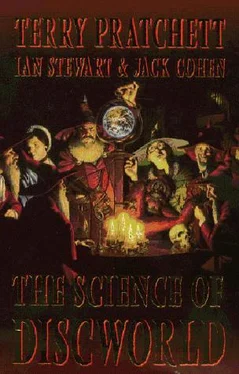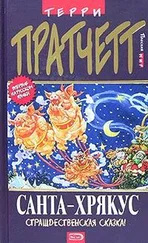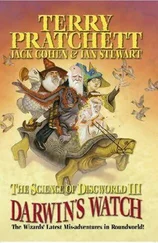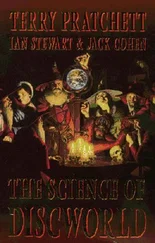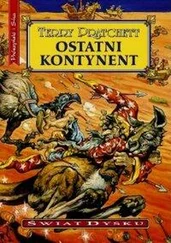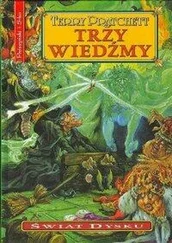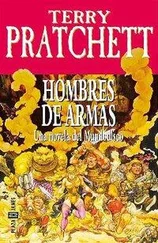Terry Pratchett - Science of Discworld
Здесь есть возможность читать онлайн «Terry Pratchett - Science of Discworld» весь текст электронной книги совершенно бесплатно (целиком полную версию без сокращений). В некоторых случаях можно слушать аудио, скачать через торрент в формате fb2 и присутствует краткое содержание. Жанр: Фантастика и фэнтези, на английском языке. Описание произведения, (предисловие) а так же отзывы посетителей доступны на портале библиотеки ЛибКат.
- Название:Science of Discworld
- Автор:
- Жанр:
- Год:неизвестен
- ISBN:нет данных
- Рейтинг книги:4 / 5. Голосов: 1
-
Избранное:Добавить в избранное
- Отзывы:
-
Ваша оценка:
- 80
- 1
- 2
- 3
- 4
- 5
Science of Discworld: краткое содержание, описание и аннотация
Предлагаем к чтению аннотацию, описание, краткое содержание или предисловие (зависит от того, что написал сам автор книги «Science of Discworld»). Если вы не нашли необходимую информацию о книге — напишите в комментариях, мы постараемся отыскать её.
Science of Discworld — читать онлайн бесплатно полную книгу (весь текст) целиком
Ниже представлен текст книги, разбитый по страницам. Система сохранения места последней прочитанной страницы, позволяет с удобством читать онлайн бесплатно книгу «Science of Discworld», без необходимости каждый раз заново искать на чём Вы остановились. Поставьте закладку, и сможете в любой момент перейти на страницу, на которой закончили чтение.
Интервал:
Закладка:
That is: beginnings start from somewhere (which is where whatever it is begins), and becomings turn Thing One into Thing Two by pushing it across a clearly defined boundary (the tooth was not carved, but now it is; the spider was not dead, but now it is). Unfortunately the universe doesn't work in such a simple-minded manner, so we have serious trouble thinking about how a universe can begin, or how an ovum and a sperm can become a living child.
Let us leave becomings for a moment, and think about beginnings. Thanks to our evolutionary prejudices, we tend to think of the beginning of the universe as being some special time, before which the universe did not exist and after which it did. Moreover, when the universe changed from not being there to being there, something must have caused that change, something that was around before the universe began, otherwise it wouldn't have been able to cause the universe to come into being. When you bear in mind that the beginning of the universe is also the beginning of space and the beginning of time, however, this point of view is distinctly problematic. How can there be a 'before' if time has not yet started? How can there be a cause for the universe starting up, without space for that cause to happen in, and time for it to happen?
Maybe there was something else in existence already ... but now we have to decide how that got started, and the same difficulties arise. All right, let's go the whole hog: something, perhaps the universe itself, perhaps some precursor, was around forever. It didn't have a beginning, it just was, always.
Satisfied? Things that exist forever don't have to be explained, because they don't need a cause? Then what caused them to have been around forever?
It now becomes impossible not to mention the turtle joke. According to Hindu legend, the Earth rides on the back of four elephants, which ride on a turtle. But what supports the turtle? In Discworld, Great A'Tuin needs no support, swimming through the universe unperturbed by any thought about what holds it up. That's magic in action: world-carrying turtles are like that. But according to the old lady who espoused the Hindu cosmology, and was asked the same question by a learned astronomer, there is a different answer: 'It's turtles all the way down!' The image of an infinite pile of turtles is instantly ludicrous, and very few people find it a satisfying explanation. Indeed very few people find it a satisfying kind of explanation, if only because it doesn't explain what supports the infinite pile of turtles. However, most of us are quite content to explain the origins of time as 'it's always been there'. Seldom do we examine this statement closely enough to realize that what it really says is 'It's time all the way back.' Now replace 'time' by 'turtle' and 'back' by 'down' ... Each instant of time is 'supported', that is, a causal consequence of, the previous instant of time. Fine, but that doesn't explain why time exists. What caused that infinite expanse of time? What holds up the whole pile?
All of which puts us in a serious quandary. We have problems thinking of time as beginning without a precursor, because it's hard to see how the causality goes. But we have equally nasty problems thinking of time as beginning with a precursor, because then we hit the turtle-pile problem. We have similar problems with space: either it goes on forever, in which case it's 'space all the way out' and we need somewhere even bigger to put the whole thing, or it stops, in which case we wonder what's outside it.
The real point is that neither of these options is satisfactory, and the origins of space and time fit neither model. The universe is not like a village, which ends at a fence or an imaginary line on the ground, neither is it like the distant desert which seems to vanish into eternity but actually just gets too far away for us to see it clearly. Time is not like a human lifespan, which starts at birth and ends at death, nor is it like the extended lifespan found in many religions, where the human soul continues to live indefinitely after death, and the much rarer belief (held, for example, by Mormons) that some aspect of each person was somehow already alive in the indefinite past.
So how did the universe begin? 'Begin' is the wrong word. Nonetheless, there is good evidence that the age of the universe is about 15 billion years, so nothing, not space, not time, existed before some instant of time roughly 15 billion years ago. See how our narrativium-powered semantics confuses us. This does not mean that if you went back 15 billion and one years, you would find nothing. It means that you cannot go back 15 billion and one years. That description makes no sense. It refers to a time before time began, which is logically incoherent, let alone physically so.
What cosmologists are pretty sure happened is this. The universe came into being as a tiny speck of space and time. The amount of space inside this tiny speck grew rapidly, and time began to elapse so that 'rapidly' actually had a meaning. Everything that there is, today, right out into the furthest depths of space, stems from that astonishing 'beginning'. Colloquially, the event is known as the Big Bang. The name reflects several features of the event -for example, that tiny speck of space/time was enormously hot, and grew in size exceedingly rapidly. It was like a huge explosion, but there was no stick of cosmic dynamite, sitting there in no-space with its non-material fuse burning away as some kind of pre-time pseudo-clock counted down the seconds to detonation. What exploded was, nothing. Space, time, and matter are the products of that explosion: they played no part in its cause. Indeed, in a very real sense, it had no cause.
The evidence in favour of the Big Bang is twofold. The first item is the discovery that the universe is expanding. The second is that 'echoes' from the Big Bang can still be detected today. The possibility that the universe might be getting bigger first appeared in mathematical solutions to equations formulated by Albert Einstein. Einstein viewed spacetime as being 'curved'. A body moving through curved spacetime deviates from its normal straight line path, much as a marble rolling on a curved surface does. This deviation can be interpreted as a 'force', something that pulls the body away from that ideal straight line. Actually there is no pull: just a bend in spacetime, causing a bend in the body's path. But it looks as if there's a pull. Indeed this apparent pull is what Newton called 'gravity', back in the days when people thought it really did pull bodies together. Anyway, Einstein wrote down some equations for how such a bendy universe ought to behave. They were very difficult equations to solve, but after making some extremely strong assumptions, basically that at any instant of time space is a sphere, mathematical physicists worked out few answers. And this tiny, very special list of solutions, the only ones their feeble methods could find, told them three things that the universe could do. It could stay the same size forever; it could collapse down to a single point; or it could start from a single point and grow in size without limit.
We now know that there are many other solutions to Einstein's equations, leading to all sorts of bizarre behaviour, but back in the days when today's paradigm was being set, these solutions were the only ones anybody knew. So they assumed that the universe must behave according to one or other of those three solutions. Science was subliminally prepared either for continuous creation (the universe is always the same) or for the Big Bang. The Big Crunch, in which the universe shrinks to an infinitely dense, infinitely hot point, lacked psychological appeal.
Читать дальшеИнтервал:
Закладка:
Похожие книги на «Science of Discworld»
Представляем Вашему вниманию похожие книги на «Science of Discworld» списком для выбора. Мы отобрали схожую по названию и смыслу литературу в надежде предоставить читателям больше вариантов отыскать новые, интересные, ещё непрочитанные произведения.
Обсуждение, отзывы о книге «Science of Discworld» и просто собственные мнения читателей. Оставьте ваши комментарии, напишите, что Вы думаете о произведении, его смысле или главных героях. Укажите что конкретно понравилось, а что нет, и почему Вы так считаете.
